

The Knowledge Project Podcast. A podcast about mastering the best of what other people have already figured out.
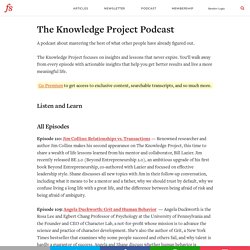
The Knowledge Project focuses on insights and lessons that never expire. You’ll walk away from every episode with actionable insights that help you get better results and live a more meaningful life. Go Premium to get access to exclusive content, searchable transcripts, and so much more. Listen and Learn All Episodes.
Students Who Gesture during Learning 'Grasp' Concepts Better. When we talk, we naturally gesture—we open our palms, we point, we chop the air for emphasis.
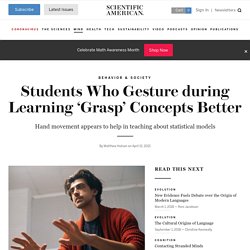
Such movement may be more than superfluous hand flapping. It helps communicate ideas to listeners and even appears to help speakers think and learn. A growing field of psychological research is exploring the potential of having students or teachers gesture as pupils learn. Studies have shown that people remember material better when they make spontaneous gestures, watch a teacher’s movements or use their hands and arms to imitate the instructor. The Power of Good Habits - Career Development From MindTools.com. © VeerMikhail Dudarev Make positive change part of your daily life.

If you've ever learned to play a sport or taken up a new personal interest, you'll know how satisfying it can feel to reach a significant goal. Giving Student Feedback: 20 Tips To Do It Right - InformED. It seems as if it was yesterday that I was a young middle school student giving a class presentation on the lifespan of the killer whale.

While I was prepared, I was also horribly nervous. At the conclusion of my speech I was given verbal student feedback from my teacher–in front of the entire class! Giving Student Feedback: 20 Tips To Do It Right - InformED. Learning Anxiety: 10 Ways to Calm Your Mind - InformED. Didaktische Reduktion. Die Umwandlung komplexer Sachverhalte in verständliche Lerninhalte stellt eine Kernanforderung an Lehrende in der Vorbereitung und Durchführung von Lernangeboten dar.
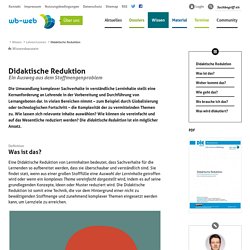
In vielen Bereichen nimmt – zum Beispiel durch Globalisierung oder technologischen Fortschritt – die Komplexität der zu vermittelnden Themen zu. Wie lassen sich relevante Inhalte auswählen? Wie können sie vereinfacht und auf das Wesentliche reduziert werden? Die didaktische Reduktion ist ein möglicher Ansatz. Folge 1: Gespräch - Warum gute Planung so wichtig ist.
Katja Ischebeck entwirft das Bild vom Trainer als Akteur auf mehreren Ebenen: in seinem oder ihrem Fachgebiet, als Lerncoach, in der Auseinandersetzung mit Methoden und Medien und in der Interaktion mit der Gruppe.

Why Your Schedule Should Have a Weekly Appointment Dedicated to "Thinking Time" Mindjet SELBSTVERSTÄNDLICH - Education. Wissen – das Verbindungselement zwischen Lernenden und Lehrenden!

Während Schüler und Studenten seit jeher auf der Suche nach der effektivsten, schnellsten und einfachsten Lernmethode sind, fragen sich Lehrkräfte häufig, wie sie den Lernstoff spannend und erfolgreich vermitteln können. Für beide Gruppen gilt: eine Flut an Informationen zu erfassen, weiterzugeben und bei Bedarf abrufen zu können. The only technique to learn something new. I had a friend who wanted to get better at painting.
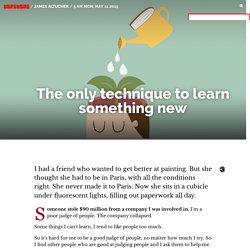
But she thought she had to be in Paris, with all the conditions right. She never made it to Paris. Now she sits in a cubicle under fluorescent lights, filling out paperwork all day. What It Takes To Change Your Brain's Patterns After Age 25. "In most of us, by the age of thirty, the character has set like plaster, and will never soften again.
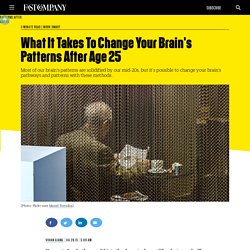
" That quote was made famous by Harvard psychologist William James in his 1890 book The Principles of Psychology, and is believed to be the first time modern psychology introduced the idea that one’s personality becomes fixed after a certain age. More than a century since James’s influential text, we know that, unfortunately, our brains start to solidify by the age of 25, but that, fortunately, change is still possible after. The key is continuously creating new pathways and connections to break apart stuck neural patterns in the brain. Simply put, when the brain is young and not yet fully formed, there’s a lot of flexibility and plasticity, which explains why kids learn so quickly, says Deborah Ancona, a professor of management and organizational studies at MIT. Focused Attention.
Education - App Store Downloads. Zeit für die wirklich wichtigen Dinge haben.
The Paperless Classroom - Home. Learning. The Early Bird Gets the Grade: How Procrastination Affects Student Scores. Sign In. Understanding the Pareto Principle (The 80/20 Rule) Designing Learning Games, Part 1: Evaluate Games. Create interactive flash tools. Q.

Who are you anyway? A. Classtools.net is the work of Russel Tarr, Head of History at the International School of Toulouse, France and author of the established website www.activehistory.co.uk. Q. Are these resources free of charge? Translational Psychiatry - The neural basis of video gaming. Video Games in the Brain: Study Shows How Gaming Impacts Brain Function to Inspire Healthy Behavior.
“Identifying a direct connection between the stimulation of neural circuits and game play is a key step in unlocking the potential for game-based tools to inspire positive behavior and improve health,” said Brian Knutson, Ph.D., Stanford University. Redwood City, CA (PRWEB) March 19, 2012 In news that could shift how game developers and healthcare professionals harness the power of videogames to do good, HopeLab and Stanford University researchers today announced new data showing that Re-Mission™, a video game about killing cancer in the body, strongly activates brain circuits involved in positive motivation (1).
This reward-related activation is associated with a shift in attitudes and emotions that has helped boost players’ adherence to prescribed chemotherapy and antibiotic treatments in a previous study (2). A growing body of data shows that digital games can positively alter players’ attitudes and behavior. How Teachers Can Motivate Students of Any Age. 50 Tricks to Study Better, Faster and with Less Stress. Studying isn’t one task, it’s many. You may need to memorize facts or just understand the basics. You might need a broad conceptual base, or just skills. Sign In. TEDxRheinNeckar - Gunter Dueck - Bildung und Mensch im digitalen Zeitalter.
Mindstation.de » Blog Archive Eselsbrücken oder warum nackte Männer mit Masken besser sind als bekleidete Skispringer » Sign In. Versal. Versal. UnBoxed: online [ Current Issue ] Proficiency-Based Learning Definition. Proficiency-based learning refers to systems of instruction, assessment, grading, and academic reporting that are based on students demonstrating that they have learned the knowledge and skills they are expected to learn as they progress through their education. In public schools, , proficiency-based systems use state learning standards to determine academic expectations and define “proficiency” in a given course, subject area, or grade level (although other sets of standards may also be used, including standards developed by districts and schools or by subject-area organizations). The general goal of proficiency-based learning is to ensure that students are acquiring the knowledge and skills that are deemed to be essential to success in school, higher education, careers, and adult life.
If students fail to meet expected learning standards, they typically receive additional instruction, practice time, and academic support to help them achieve proficiency or meet the expected standards.
The Power of Storytelling in eLearning by Jennifer Neibert. “What would happen if we took a deep breath, stepped away from the storyboard, and crafted a fascinating narrative to guide our learners? One that our learners felt and experienced on an emotional level; that elicited a response to go, or change, or do; and above all, that resulted in the meaningful change we’re really seeking—now that’s a powerful tale!” Lerntheorien - Learning Theory Concept Map. Lerntheorien – Learning Theory Concept Map: Richard Millwood hat sich der Aufgabe gestellt, Lerntheorien systematisch in einer Concept Map darzustellen. Das Ergebnis ist eine vernetzte Veranschaulichung von Lerntheorien und deren Vertretern sowie den zugehörigen “Weltanschauungen” und Schlüsselkonzepten … Die Concept Map in der Version v6 (vom 30. April 2013) mit anklickbaren Wikipedia-Links gibt es auf dem Concept Map Server von Cmap.
Magazin Lehrer. Jon Bergmann, der Erfinder des Flipped-Classroom-Konzepts, erklärt in seinem Gastbeitrag, was die größten Hürden sind, wenn Lehrer das „Klassenzimmer umdrehen”. Bei diesem Unterrichtsstil eignen sich Schüler und Schülerinnen den Lernstoff per Lernvideo zu Hause an und bearbeiten dazu am nächsten Tag Aufgaben und Übungen – mit Unterstützung der Lehrkraft. Lernen mit IT. Die LEARNTEC ist die Internationale Fachmesse und Kongress für Lernen mit IT, vom 27. bis 29. Individuals, Institutions and Organizations Committed to Quality Online Education. The 7 Transformational Concepts in The 21st Century Education. A Great Study Skills Poster for Your Class. Learning is a lifelong process. E-Learning and Online Teaching. Notes From McTeach: Learning to Blog Using Paper.